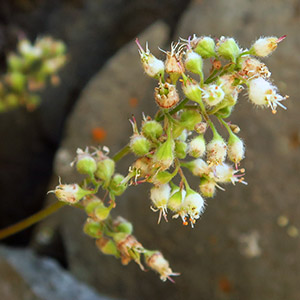Heuchera merriamii
Heuchera novamexicana
Canyon Creek alumroot, Merriam's alumroot
range alum-root
11–32 cm, long stipitate-glandular or glabrate.
30–50 cm, short or long stipitate-glandular.
petiole (2.4–5 cm), moderately long stipitate-glandular;
blade orbiculate, reniform, or pentagonal, shallowly 5–7-lobed, 2.5–4.5 cm, base shallowly cordate to truncate, lobes rounded, margins dentate, apex rounded to obtuse, surfaces finely long stipitate-glandular abaxially, sparsely long stipitate-glandular adaxially.
petiole glabrous or long stipitate-glandular;
blade reniform or rounded-cordate, shallowly 5-lobed, 2–6 cm, base cordate, lobes rounded, margins dentate, apex obtuse, surfaces long stipitate-glandular on veins abaxially, glabrous or short stipitate-glandular adaxially.
dense; (bracts linear and scarious to 3–5-parted and herbaceous).
dense.
hypanthium radially symmetric, free 0.5–1.5 mm, pink, hemispheric, 3–5.5 mm, (base rounded), densely long stipitate-glandular;
sepals erect, green- or red-tipped, equal, 1–2 mm (often wider than long), apex obtuse;
petals erect, white, oblanceolate, (clawed), unlobed, 2–3.5 mm, margins entire;
stamens exserted 0.8–2 mm;
styles exserted 1–2 mm, 1.5–2.5 mm, 0.1+ mm diam.
hypanthium radially symmetric, free 1–1.8 mm, cream or yellowish green, broadly campanulate, 3–5 mm, short stipitate-glandular;
sepals erect or incurved, green-tipped, equal, 0.6–1.2 mm, apex ovate;
petals usually erect, white, elliptic, (not clawed), unlobed, 0.5–1 mm, margins entire;
stamens included 0.5 mm; (filaments erect or incurved distally, equaling and not concealed by anthers);
styles included 0.5–1 mm, 0.5–1 mm, 0.1+ mm diam.
ovoid, 3–5 mm, beaks divergent, not papillose.
ovoid, 5.5–6.5 mm, beaks divergent, not papillose.
dark brown, ellipsoid, 0.6 mm.
dark brown, asymmetrically ellipsoid or convex-fusiform, 0.5 mm.
= 14.
= 14.
Heuchera merriamii
Heuchera novamexicana
Heuchera merriamii is known from the Siskiyou and Trinity mountains.
(Discussion copyrighted by Flora of North America; reprinted with permission.)
Heuchera novamexicana occurs in the mountains of Arizona and New Mexico. Populations with glabrous petioles may be found in the Organ Mountains of New Mexico; elsewhere, long stipitate-glandular petioles are more common in the species.
The Navajo Indians took a decoction of roots of Heuchera novamexicana for internal pain. They applied a poultice of split roots to infected sores, swellings, and fractures, and used the plant as a panacea or “life medicine” (D. E. Moerman 1998).
(Discussion copyrighted by Flora of North America; reprinted with permission.)


